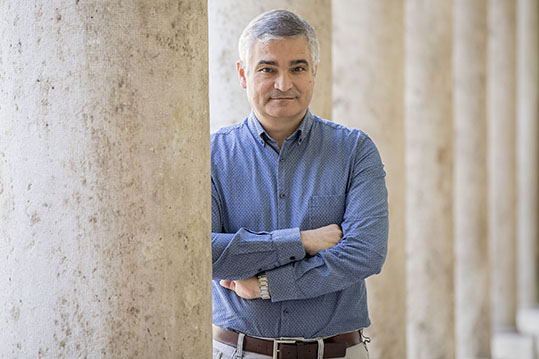Adrià Besó: “We will bring the cultural patrimony of the Universitat de València closer”
- November 6th, 2018

Anna Boluda. Photos: Miguel Lorenzo
Adrià Besó is the new curator of the Cultural Patrimony of the Universitat de València. He is an expert in the field and he is faced with the challenge of updating and uniting all the collections of the University, which range from historic artistic pieces to scientific tools, the Botanical Garden or the bibliographical repertoire. One of its main objectives is to bring closer all these treasures of the university community and general society.
– What are the main tasks that you have as a curator of the cultural patrimony of the Universitat de València?
– The duties are focused mostly around the historic artistic collections of the Universitat de Valencia, which are located in La Nau and in some faculties. There are pieces from the past, but also modern collections with great artistic quality. Besides, my main duties encompass the collaboration with the patrimony of the Universitat, which is very rich and varied. One of the projects I am currently working on is the general inventory of all this patrimony.
– What are the main collections that make the cultural patrimony of the Universitat?
–As a result of the research and teaching task that the Universitat has been carrying out for more than five centuries, we have different collections organised thematically. One of these is the scientific and medical collection which has instruments of the Faculty of Medicine. Another block is in the old history museum and it contains collections on Geography and Zoology. Its origin lays in the museum that previously existed in La Nau – it burned down in 1932, but many of the pieces were saved thanks to the students.
The Botanical Garden and the bibliographical collections of the old library of the University are also a very important part of this cultural patrimony not only because of the manuscripts and books, but also because of the graphic works such as Civil War posters. The pictorial collection Martínez Guerricabeitia, a donation by this Valencian businessman, includes contemporary art.
On the other hand, we also have the collection of the Astronomical Observatory, which contains the original telescope now located in the Office of the principal. This collection also includes the original office of Ignacio Tarazona, founding father of the Observatory, and other instruments that are currently preserved in the facilities of the Science Park in Paterna. In the Centre del Càlcul of the University there is also a collection on the technologies of information and communication. This collection goes over the history of computing in the last fifty years through computers and other devices.
In the end, we also have the historical artistic collections, which are mainly located in the different spaces of La Nau: Paranimf, the chapel and the rectoral rooms. It has various remarkable paintings such as the ones of the galleries of portraits of vice-chancellor and “Nuestra señora de la sapiencia”, by Nicolau Falcó.
– What is the conservation state of all this cultural patrimony?
– The conservation state is good, but it is a never ending task. It is necessary to continue with preventive conversation and bear in mind that, because of the natural ageing of some pieces, it will be needed to do some intervention task. Despite all of this, however, the state of the collections is excellent.
–What are the main challenges that you face as the new curator?
–The inventory task is fundamental as we cannot manage our patrimony well without knowing what we have exactly. Our collections are enormous and not all of them are detailed even though great effort has been put into this task in the last years. Therefore, it is now the moment to carry out a general, inclusive inventory through a unique data base. We will use Omeka, a free software which is already been used in other Spanish universities, in order to make it accessible to researchers and the general public. In addition, because we believe that cultural patrimony should not only be local but worldwide, we will incorporate this information into the big, free access European data bases. Such as Icom and Europeana.
Besides the inventory, we want to continue studying in depth the collections we already own as well the conservation of the works. One of the most important challenges we have set for ourselves is the improvement of divulgation and spreading of all this patrimony – we will bring the cultural patrimony of the Universitat de València closer.
– How have you planned the improvement on the spreading of the cultural patrimony onto a general public?
–We have to increase our visibility and have it reach general society. Besides, the more we know about the patrimony, the more it is appreciated and more guaranteed is its protection and conversation. We will continue doing exhibitions so as to show all the collections we own and the publications on the cultural assets of the University.
In addition, we will pay special attention to the “e-patrimony” and we will take advantage of digital media for its spreading. So far, we have opened our Facebook face and we are working to be up to date in all social media, as many museums are already doing. We are also creating a virtual visit through Google Maps of the historical building of La Nau and its many areas. We have also thought of outlining one work each month. By doing so, we will be able to complement the divulgation tasks that have been taking place through the year and we will reach other public sectors.
File in: Patrimoni Cultural , Cultura













